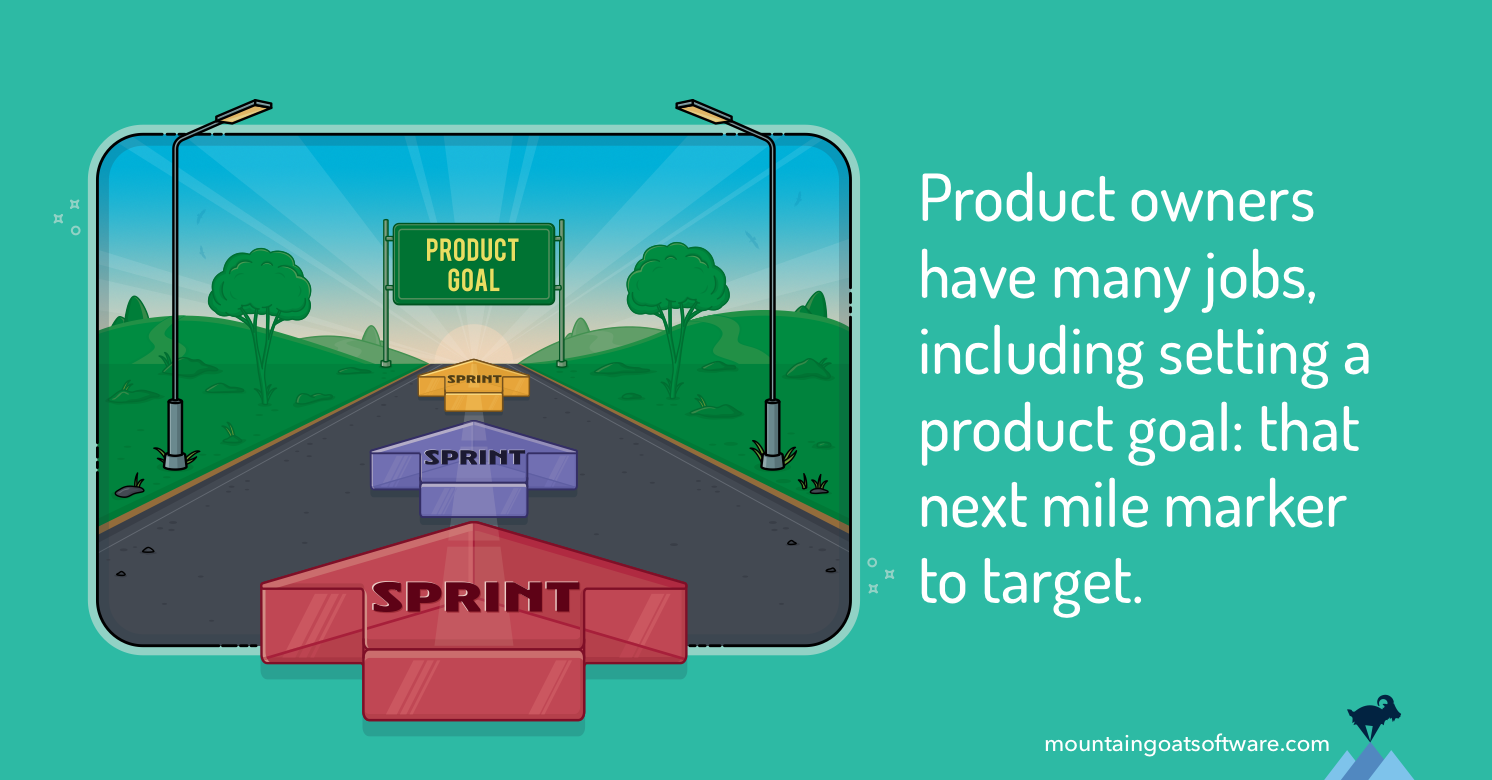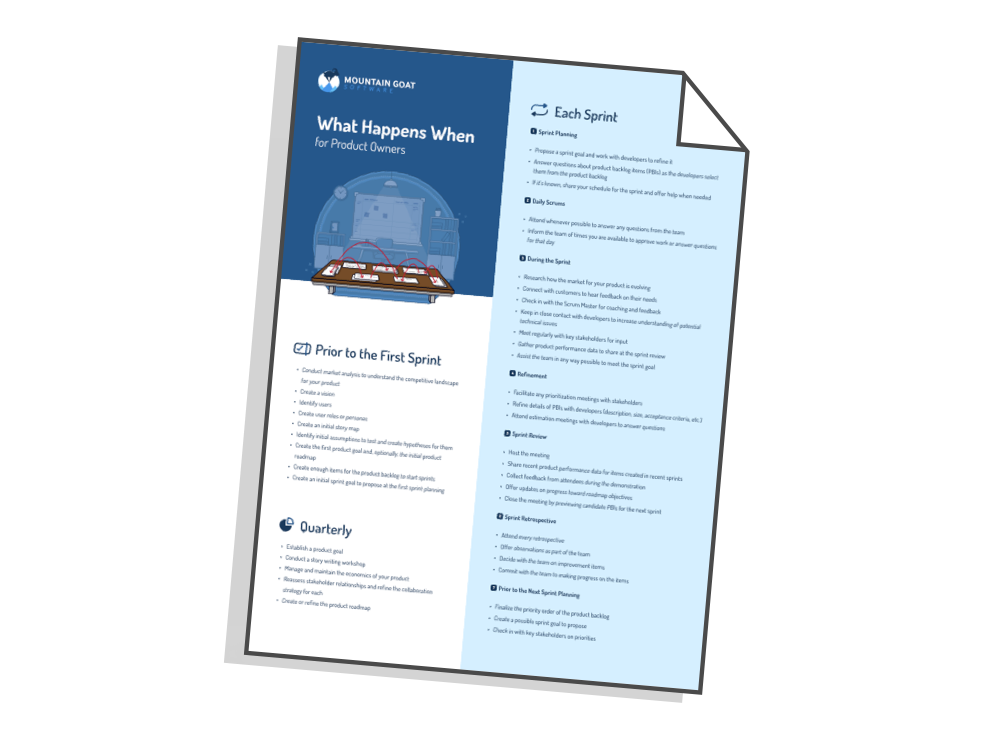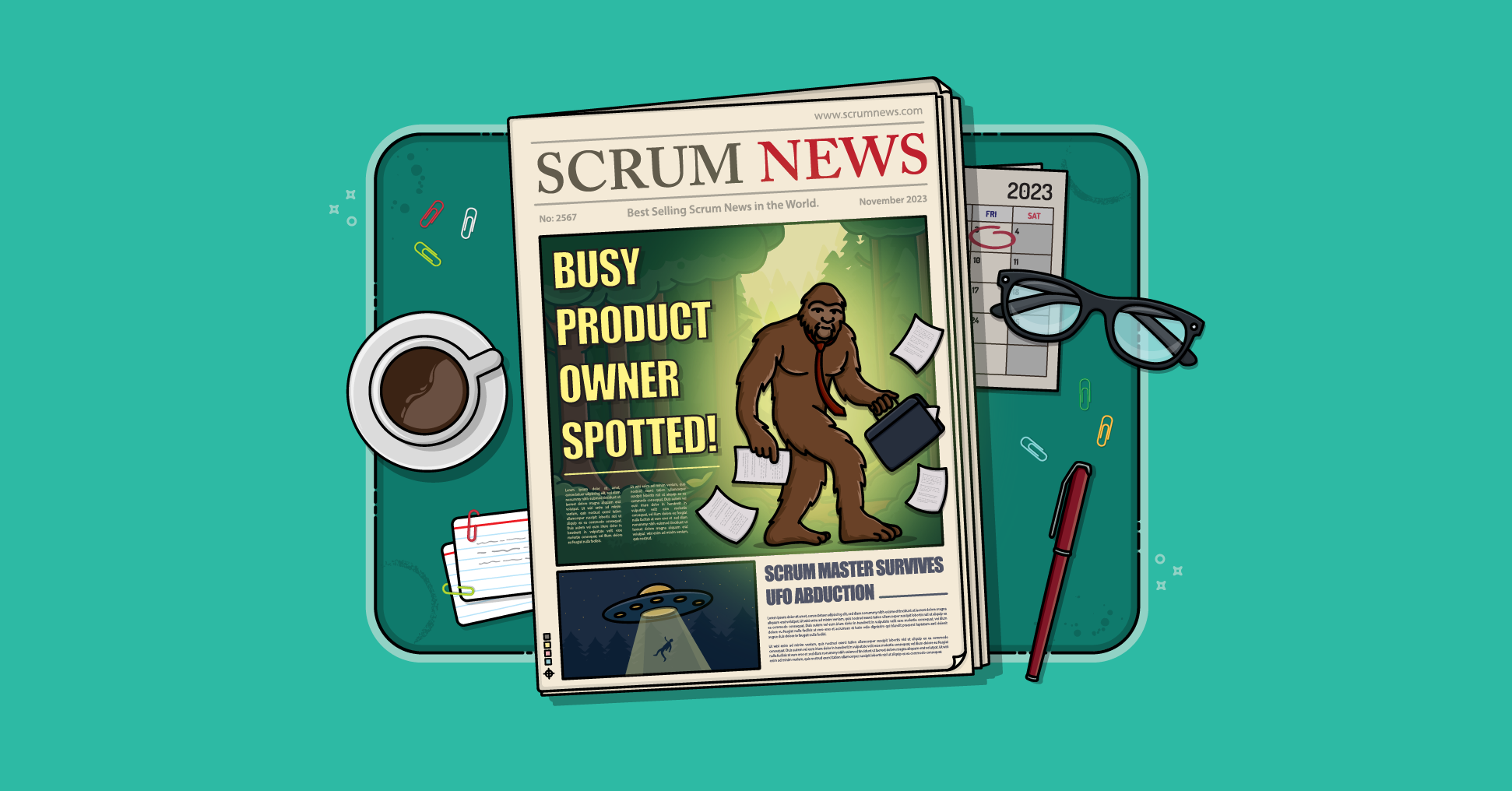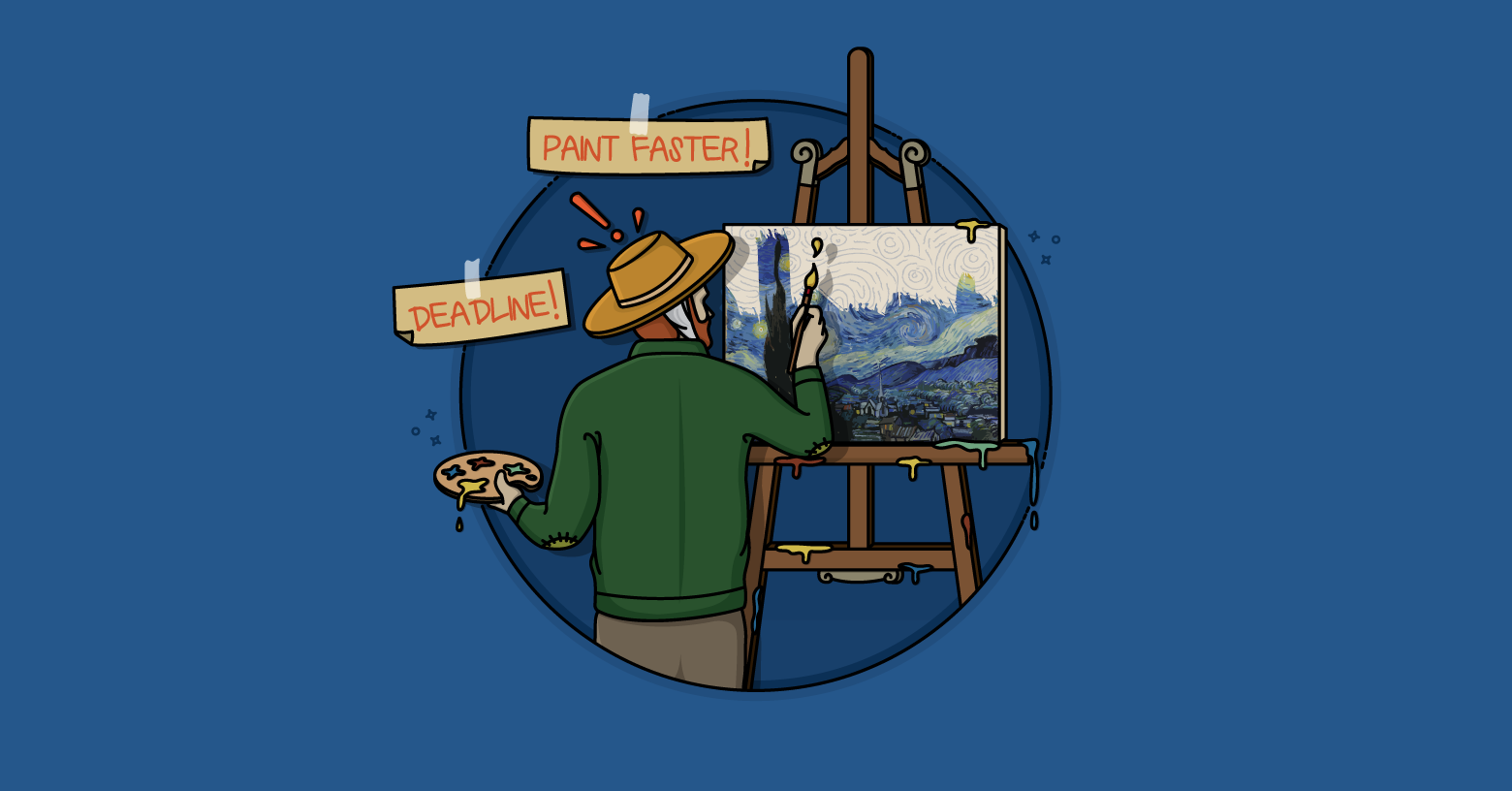How do product owners get everything done? What does their process look like before projects begin, quarterly, and during each sprint? Why do they even do certain things?
Recently, on the Agile Mentors Podcast, Brian Milner played host to guest Mike Cohn, with a plan to get Mike Cohn’s insights on just that–what does a product owner do, when and why?
Brian explained his plan to Mike and asked, “Does that sound about right, Mike?”
“That’s what we agreed to do, but it’s not what I’m going to do!” Mike replied, laughing.
Mike went on to explain that he actually wanted to turn the tables on the podcast and interview Brian for a change.
As the mastermind behind The Definitive Guide to the What and When of Product Owner Responsibilities, Brian found himself in the hot seat. And he was ready, explaining not only what product owners do, and when, but why they do it.
A Product Owner’s Work Is Chronological and Cyclical
The Definitive Guide to the What and When of Product Owner Responsibilities is organized, quite naturally, by timeframe, considering the chronological and cyclical nature of the product owner’s responsibilities:
- Chronological: Most projects are at least somewhat time bound, constrained by dates or cost (or sometimes both). All sprints follow a specific order of events, from planning to the retrospective.
- Cyclical: Most projects contain multiple sprints, as well as a cycle of "larger than one sprint" check-ins and research activities.
Product owners are part of the Scrum team and vital to the work itself. At the same time, they serve as communication conduits between teams and stakeholders. Product owner responsibilities are spread throughout the project lifecycle to support a healthy pace and offer the flexibility to tweak the plan to better meet customer needs. Pro tip: There will always be tweaks to the plan.
To understand how and when a product owner’s work occurs and recurs during projects, it helps to unpack why the work is important. The responsibilities of successful product owners can be organized into six actions–each one containing a “why” and key activities occurring at certain times and a regular cadence. Podcast quotes from Brian provide further insight into why product owners take these six actions.
6 Actions of Successful Product Owners
Good product owners know what to do and when to do it. Great product owners understand why their responsibilities exist in the first place. They keep these six actionable pillars in mind throughout the project, from before a first sprint to the final launch.
1. Product Owners Understand the Market
To deliver the best product for their customers, product owners must understand customer needs and wants, and how competitors are addressing them. They should prepare to encounter challenges to their initial beliefs, and changes to where they fit in this evolving landscape.
Before the First Sprint
- Analyze market trends and competition, especially for outward-facing products. Pay attention to how this challenges assumptions and tweaks product vision.
- Figure out who users are and set up the big picture with a story map. Remember that story maps are living documents, and subject to change as understanding evolves.
Quarterly
- Choose the next product goal as a guide for what to deliver, and in what order to deliver it.
- Check on established story maps to see what needs adjusting.
During Each Sprint
- Suggest a sprint goal and the backlog items that will support an understanding of customers’
- Speak to actual customers throughout product development, and keep an eye on what competitors are up to.
2. Product Owners Know and Engage Stakeholders
Before product owners take the vision and story map to the team, they must define them with the stakeholders and organization. That doesn’t mean everything is set in stone, but it’s important to start building that relationship at the outset.
Before the First Sprint
- Identify stakeholders, and seek their support for the product vision and plan.
- Conduct a few rounds of story mapping with stakeholders, openly discussing that certain aspects may change as the team moves forward.
Quarterly
- Revisit relationships with stakeholders, refining collaboration strategies and keeping excitement.
- Address significant changes to the road map, emphasizing the team’s commitment to the product, even when that means altering well-laid plans.
During Each Sprint
- Regularly meet with stakeholders for their input, feedback, and buy-in.
- Facilitate prioritization meetings ahead of backlog refinement, including stakeholders in sprint reviews and retrospectives.
3. Product Owners Maintain the Product Backlog
The product backlog is a living, breathing document, subject to change as product owners’ understanding evolves. No formula can reveal exactly how much should be in it at the start of a new project–the important thing is that it adapts along with the project.
Before the First Sprint
- Establish the product goal, have a story-writing workshop, and create a product roadmap.
- Write a backlog, but don’t get so caught up in it that there’s a delay getting started on the project itself.
Quarterly
- Update the product roadmap, if necessary.
- Know that some people will become attached to the existing backlog and roadmap, and struggle with changes. Reiterate that fluidity is vital and changes are healthy.
During Each Sprint
- Ensure the backlog is up to date before refinement meetings with stakeholders.
- At the review, look ahead at what’s coming up in the backlog in preparation for the next sprint.
4. Product Owners Build Trust
Product owners need to prioritize trust with team members and stakeholders at every step and turn of a cycle.
Before the First Sprint
- Set realistic expectations–it’s better to exceed them than to fall short.
- Use tools like story maps and roadmaps to promote visibility into what the team’s creating and what might not make it into the final product.
Quarterly
- Check in to see if the current plans reflect the current reality.
- Track product economics and communicate them with the team and stakeholders.
During Each Sprint
- Check in with the stakeholders on priorities, plans and progress.
- Ensure that stakeholder input is reflected in the backlog.
5. Product Owners Behave as Good Teammates
Product owners certainly have their own set of accountabilities that set them apart from the rest of the team. That said, product owners are definitely part of the team. It’s vital that they are present and participate with the team, not at them.
Before the First Sprint
- From the beginning, involve future teammates, inviting at least some of them to estimating and story writing before the official launch.
- Set a precedent of sharing a calendar, as appropriate, so team members can plan for important check-ins. Consider offering a guaranteed daily or weekly block of time when teammates can bring questions and concerns.
Quarterly
- Work alongside the team in writing new stories and refining product goals and roadmaps.
- Check in with and update team members on significant shifts in projects.
During Each Sprint
- Participate in sprint planning, daily scrums, and sprint retrospectives and host sprint reviews.
- Be available to refine backlog items, answer questions and highlight progress.
6. Product Owners Start Where They Are and Improve with the Process
Good product owners don’t get caught up in perfectionism. It’s better to start with the intention to improve than to delay getting started until every possible detail is set in stone. Product owners who take it one step at a time and walk alongside their team will get where they need to go.
What Should a Product Owner NOT Do?
Mike’s final question to Brian might be the perfect way to wrap up the advice for product owners:
Mike: “What's the one thing you would tell product owners to not do?”
Brian: “Understand the boundary between the what and the how, and really try to stay out of the how. We're in charge, as product owners, of the what side of the equation. What is it that we're going to be doing? What are we focused on?
“The developers are in charge of the how. How do we accomplish this? What's the best way to deliver this?
Last update: July 1st, 2024








